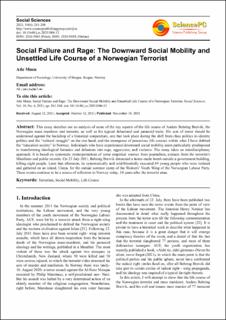Social Failure and Rage: The Downward Social Mobility and Unsettled Life Course of a Norwegian Terrorist
Journal article, Peer reviewed
Published version

Åpne
Permanent lenke
https://hdl.handle.net/11250/2993053Utgivelsesdato
2021Metadata
Vis full innførselSamlinger
- Department of Sociology [422]
- Registrations from Cristin [9482]
Sammendrag
This essay sketches out an analysis of some of the key aspects of the life course of Anders Behring Breivik, the Norwegian mass murderer and terrorist, as well as his typical delusional and paranoid traits. His acts of terror should be understood against the backdrop of a historical conjuncture, one that took place during the shift from class politics to identity politics and the “cultural struggle” on the one hand, and the emergence of precarious life courses within what I have dubbed the “education society” in Norway. Individuals who have experienced downward social mobility seem particularly predisposed to transforming ideological fantasies and delusions into rage, aggression, and violence. The essay takes an interdisciplinary approach. It is based on systematic reinterpretations of some empirical sources from journalism, extracts from the terrorist’s Manifesto and public records. On 22 July 2011, Behring Breivik detonated a home-made bomb outside a government building, killing eight people. Later that afternoon, he systematically and cold-bloodedly executed 69 young people who were isolated and gathered on an island, Utøya, for the annual summer camp of the Workers’ Youth Wing of the Norwegian Labour Party. These events continue to be a source of reflection in Norway today, 10 years after the terrorist attac.
